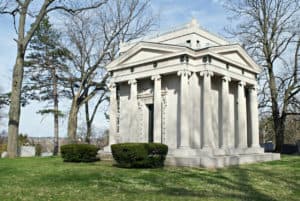William Rockefeller Mausoleum
Classical
William Rockefeller
May 31, 1841-June 24, 1922
The largest mausoleum in Sleepy Hollow was built in 1920. It houses the remains of members of the William Rockefeller family. William Rockefeller was born in Richford, New York, and then moved with his family to Strongsville, Ohio in 1853. He started a refinery in 1865, which was acquired by his brother, John D. Rockefeller in 1867. That company became Standard Oil. William Rockefeller then became interested in the copper business and along with his business partners tried to control the copper industry. The business machinations proved successful and the Anaconda Copper Company went on to become the fourth largest company in the world. William Rockefeller kept a much lower public profile than his brother John D. Rockefeller and was considered to be much more friendly and personable than John D..; When he died, the gross value of his estate was estimated at 102 million dollars. He had requested a simple funeral, but nevertheless, the service received attention in the papers. Of special note was the number of servants that were allowed to attend the funeral including a bootblack who had served him for forty years. Next to be interred in the mausoleum was William Goodsell Rockefeller who died on December 3, 1922.
William Rockefeller was known for his ability to work with others and form a team to reach a common goal. His mausoleum was truly a group effort. His impetus for building the mausoleum was the to provide a dignified final residence for his wife of 56 years, Almira Geraldine Goodsell Rockefeller (1845-1920). Rockefeller hired Welles Bosworth (1868-1966) an Ecole de Beaux Arts trained architect. At the time, Bosworth was most noted as being the lead architect for the Pan-American Exposition held in Buffalo in 1901. John D. Rockefeller later hired Bosworth to oversee a number of Rockefeller’s projects in France including the restoration of the Palace of Versailles. Bosworth’s design for the William Rockefeller mausoleum called for a classical revival style tomb with engaged Ionic columns and a stepped pyramid-style roof. The mausoleum is 35 feet 6 inches across the front, 43 feet 8 inches deep and 38 feet 5 inches high. The walls are 16 inches think.
The Presbrey-Leland Company, one of the premier monument builders of the time, executed the actual construction of the mausoleum. The firm still operates today. Overseeing the project was monument builder William Crawford. Crawford chose Barre, Vermont granite for all the structural elements. Of special note is the 10-foot wide, 30-foot long 14-inch thick granite walkway that was carved from a single slab of granite. Inside the mausoleum there are 20 wall crypts. The cella (interior space of the mausoleum) is 12 feet by 18 feet 2 inches. In the cella are two marble sarcophagi for William and Almira Rockefeller. Other architectural details include a bronze door and other bronze details fashioned by the William H. Jackson Company of New York and slate crafted by the Structural Slate Company of Pen Argyl (argyl is Greek for slate rock), Pennsylvania). The bas-relief above the entry has been attributed to French born sculptor Gaston Lachaise. A number of granite-covered graves of other members of the extended Rockefeller family pepper the lawn area outside the mausoleum. Despite the mausoleum’s grand scale and prominent siting, William Rockefeller kept his name low key. Rather than have his name in bold letters in the frieze area over the entry he chose to modestly place it on the lower step of the stylobate (out of view on the far left; it echoes the anno domini 1920 on the lower step of the stylobate on the far right right).
Text and photo © Douglas Keister Visit Doug’s Author Page
[address cemetery=”Sleepy Hollow Cemetery” street=”540 N. Broadway” city=”Sleepy Hollow” state=”New York” zip=”10591″]


